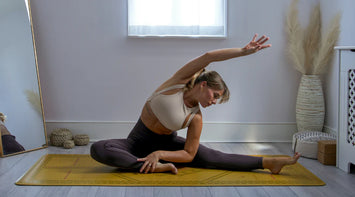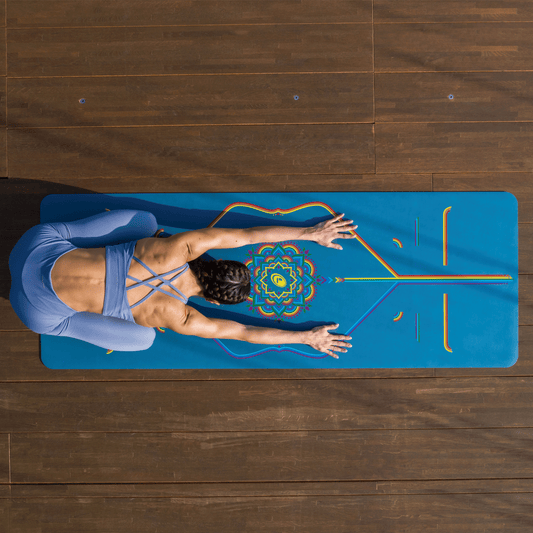Yoga students looking for inspiration in Patanjali’s Yoga Sutras tend to focus initially on the yamas, which offer guidance on how yogis should interact with the world. The yamas are very actionable; you can see how to put principles like ahimsa (non-violence) or asteya (non-stealing) into practice. It may not be easy to change your behaviour, but it’s pretty clear how to.
Some of the niyamas, on the other hand, are a little trickier. There’s often not a straightforward way to bring them into fruition. This is undeniably true of santosha, the niyama that means contentment. It sounds like something we definitely want, but how do we get there?
Contentment Can't Wait
Many of us think of contentment (if we think of it at all) as a far-off goal; something you might get to eventually once everything else lines up just the way we’ve always wanted and all the problems go away. Perhaps in our golden years in the house on the hill with grandkids gambolling on the lawn, we’ll finally feel content. But (spoiler alert!), that’s not really how things work.
Things rarely come out the way we’ve fantasised because things are always changing: our goals change, our paths diverge, we meet people we never could have imagined, old doors close and new ones open all the time. Yoga encourages us to be in the present moment as much as possible, so it doesn’t make any sense to put off something as crucial as contentment for the uncertain future. Once we realise this, we can work on finding contentment now.
Santosha Is an Inside Job
We won’t get much help from today’s goals-driven culture. Contentment doesn’t make for clicky headlines (10 Ways to be Just Fine With What You Already Have?) and seeing other people’s apparently perfect lives isn’t conducive to feeling ok with our own messiness.
It takes some time and some introspection (muscles that are hard to flex when instant gratification is the norm) to realise that what everyone is after isn’t actually flashy cars or McMansions, it’s a way to signal that we’re ok with ourselves. If we can see through the miasma of stuff and status, then we can get to the santosha mindset more directly and skip the narrative where it’s dependent on getting the dream job, dream house, and dream partner.
Nothing external is going to deliver happiness on a silver platter because contentment is an inside job. The #goal is not to achieve the trappings of someone else’s symbols of wealth, achievement, or even health. Instead, it’s to find joy in your present circumstances, whatever they are.
What About Complacency?
But wait, you might be thinking, what about staying hungry, what about getting to the top, what about the eye of the tiger? Won’t contentment lead to complacency? This is a misunderstanding of what contentment means. It’s not the end of growth. It’s not the period at the end of the sentence. It’s not about settling for less than you deserve or lying down and accepting the status quo.
It is about being ok with yourself regardless of your situation. When we talk about doing the work in yoga, the work is not nailing a difficult pose. The work is coming to a place where doing the pose or not doesn’t impinge on our self-worth. As is so often the case, the work we do on the mat reverberates into all corners of our lives. You still change and grow but you become less attached to the results because your happiness is not based on results.
Realising that santosha doesn’t hinge on perfection is crucial. It’s a state of mind in which we can experience ups and downs, highs and lows, and then return to something like equilibrium. Our boats can still be rocked but they don’t capsize quite as easily.
Enter Gratitude
Practising gratitude is something you CAN do to strengthen your relationship with contentment. Taking time to feel grateful is known to improve your sense of well-being, as well as your mental and physical health. You might not be sure how to express gratitude but it’s actually pretty simple. Many people make it a daily practice, although it’s been shown to be just as effective to do it once a week.
‘It’ can take several forms. Writing in a gratitude journal is one option. Coming up with five good things in your life and putting them down on paper helps tip the scales toward contentment quite a bit. It’s a strong counter to the type of negative comparisons that often run like a ticker-tape across our consciousnesses. Focusing on the things you have going for you is much more beneficial than dwelling on what you are lacking.
If keeping a journal isn’t your style, try a short meditation instead. Sit down, close your eyes, and think of a few things you are thankful for. It could be the same things every time as long as you take a moment to really feel how these things lift you up.
Contentment Now
Contentment doesn’t have to wait until you’re older/wiser/have accomplished more. It isn’t something that you should count on enjoying later. Like many things in yoga, santosha may look like a goal but it’s really more of a process. The first step is recognising what you already have, not in terms of material possessions but in the intangibles like love and community. Those are the roots from which happiness can grow.
Love,
Liv x




































